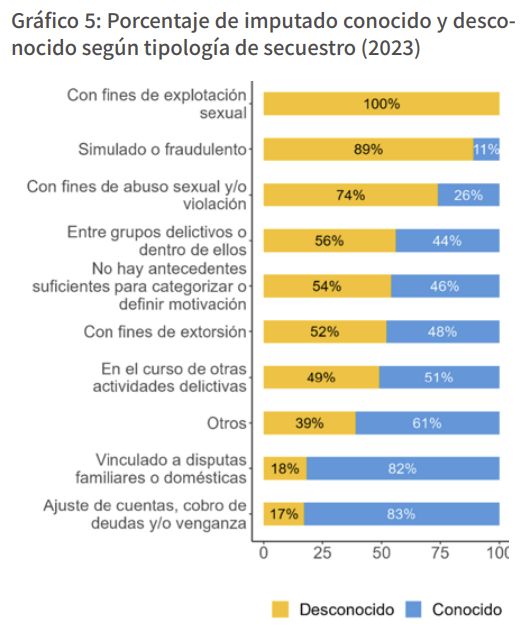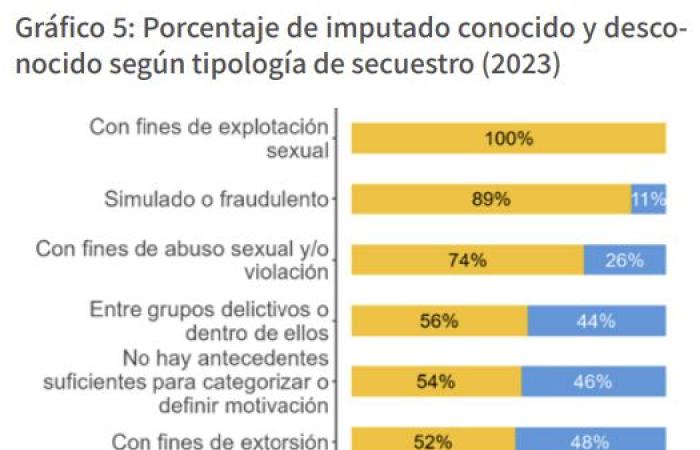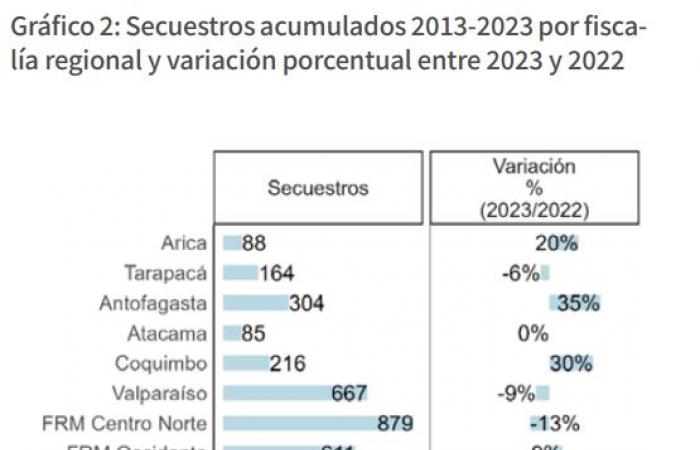It was 3:05 in the morning last Friday, November 10, when, after 35 hours without knowing his whereabouts, they released the 50-year-old businessman Rudy Basualdo Castillo, after the alleged payment of around 40 million pesos.
The kidnapping that occurred in Rancagua – and which today has eight people detained – is only one of the 850 registered in 2023, 2.9% more than the previous year. Although this figure is equally worrying, it has decreased compared to the 68% increase recorded between 2021 and 2022, demonstrating some control over the situation.
This is established in the “Report No. 2 on Criminal Phenomena and Kidnappings” carried out by the Division of Studies, Evaluation, Control and Management Development of the National Prosecutor’s Office. Report that analyzed the contexts and characteristics of the causes of this type of crime, recorded during the past year, in order to evaluate the effectiveness of the crime prevention and prosecution policies adopted by the Government.
In addition to the slight increase in kidnappings, the Public Ministry revealed that similar patterns have been shown between 2022 and 2023, except for a four percentage point increase in those associated with organized crime.
The report also drew attention to the significant number of cases associated with family disputes, with the main relationships being partners or ex-partners, and with female victims.
Results
Until five years ago, kidnappings were not a priority in the reports of institutions responsible for criminal prosecution or prevention in Chile. However, this reality has changed dramatically.
In the last three years, there has been a transformation in the country’s criminal landscape, marked by a increase in armed violence, an increase in the homicide rate and the presence of criminal organizations with international tiesattributable to the high number of irregular immigrants.
In this context, the report seeks to portray this new reality annually, through the analysis of the causes of kidnapping. Cases to which the latest complaints published by the press are expected to be added in the next report in 2024, such as the two Venezuelans kidnapped in Renca in February; a man kidnapped in Los Angeles and later released for $40,000 in June; a woman kidnapped at the Central Station bus terminal, with the participation of her partner under investigation; a young man forced into a vehicle outside the University of Santiago, among others.
Last year, the National Prosecutor’s Office published a historic figure on the increase in kidnappings, registering an increase of 67.8% from 2021 to 2022 at the national level. While 492 investigations for this type of crime were initiated in the first year, the number increased to 826 the following year.
For 2023, the increase continued, as confirmed by the general director of Carabineros, Ricardo Yáñez, in the institution’s public account carried out last Tuesday the 18th, although with a much lower intensity. Last year, 24 more kidnappings were recorded than in 2022, equivalent to an increase of 2.9%.
The increase in the last two years is alarming, since 28.5% of all kidnappings of the decade occurred between 2022 and 2023.
Domestic violence
Last year, the majority of kidnappings were linked to family or domestic disputes, with this motivation accounting for 18.7% of all kidnappings in the country.
Consequently, the majority of victims were women, held against their will in many cases by their partners or ex-partners.
In 38% of all cases analysed, it was concluded that the victim and the accused or suspect knew each other before the crime, with 46% of this group corresponding to relationships between partners or ex-partners.
This year, too, we have seen a similar situation, as in the case of the investigation initiated by the Temuco Prosecutor’s Office into a man who allegedly kidnapped, raped and beat his partner for 15 days at the beginning of last May.
The second strongest motivation analyzed by the report were those kidnappings typically associated with organized crime because they are linked to extortion purposes, settling scores, criminal groups and for the purposes of sexual exploitation.
By 2022, these four typologies reached 23%, increasing to 27% in 2023.
Regarding this topic, the report highlighted the recent implementation at the end of 2023 of the Organized Crime and Homicide (ECOH) which has 240 professionals deployed throughout ten regions of the country.
The effectiveness of the new specialized group of the Public Prosecutor’s Office and its impact on organized crime rates should be analyzed in the next annual report.
However, 23% of the kidnapping cases in 2023 did not have sufficient information to be able to define the motivation for the kidnapping, which accounts for the absence of key antecedents to guide the initiation of criminal investigations.
The other features
In addition to the motivations, the report stated that fairly similar patterns were maintained between the characteristics of kidnappings between 2022 and 2023.
A relevant variable linked to the level of complexity that an investigation may have is the percentage of unknown defendants. For the kidnappings analyzed in 2023, this value reached 39%, ten percentage points lower than that observed in 2022.
The knowledge or ignorance of the perpetrator (or perpetrators) of the crime varied depending on the type of kidnapping, with 100% of the accused not knowing about those for the purposes of sexual exploitation, followed by 89% in simulated or fraudulent kidnappings, and 74% in kidnappings for the purposes of sexual abuse and/or rape.

Likewise, the Public Ministry also provided figures on the number of defendants per case, concluding that on average, three individuals participated in each kidnapping, a number almost identical to that reported in 2022.
On the other hand, only in 1% of cases was the involvement of a criminal gang mentioned in police reports, the figure having been 5% in 2022.
Regarding the nationality of the accused, 25% of them were foreignersan increase of ten percentage points compared to 2022. The largest nationality detected was Venezuelan (73%), followed by Colombians (11%), registering a greater participation of the former towards 2023, and a decrease of the latter.
In addition, the report highlighted a high rate of repeat offenders in the cases analyzed, with 88% of the accused being involved in other crimes in addition to kidnappings, accumulating an average of 12 additional crimes.
Finally, in 27% of cases firearms were used to commit crimes – a slight decrease compared to 2022 – and in 18% of cases knives or blunt objects were used, suggesting that Direct physical violence continues to remain a method used to restrain victims.
Regarding the scene of the events, 32% of kidnappings were committed in public places, the car being the preferred means not only to approach and transport the victims, but also as a physical space where the restraint was carried out, in 28% of the cases. In over half of the cases investigated, there was the presence of a car for the commission of crime, figures that behaved in a practically identical manner to the previous year.
A geographical vision
In this last decade, the largest number of cases for this crime were in the Metropolitan Regional Prosecutor’s Office, North Center, covering the municipalities of Santiago, Quinta Normal, Estación Central, Quilicura, Renca, Huechuraba, ConchalÍ, Independencia, Recoleta, Cerro Navia and Lo Prado.
This was followed by Metropolitan South Regional Prosecutor’s Office – led by prosecutor Héctor Barros Vásquez – and which includes the communes of San Miguel, La Pintana, El Bosque, San Ramon, La Granja, La Cisterna, San Joaquin, Pedro Aguirre Cerda, Lo Espejo, Puente Alto, San Jose de Maipo and Pirque.
Although the four prosecutor’s offices in the Metropolitan Region account for 48% of kidnapping cases, the third prosecutor’s office with the most investigations into this type of crime is Valparaíso, led by Claudia Perivancich Hoyueloswhich accounted for 11.4% of kidnappings nationwide.
Rates of fewer kidnappings In the last ten years, the regions led by Aysén, with 17 cases; Magallanes, with 23; and Atacama, with 85.
Between 2022 and 2023, regions that have experienced a significant increase in the number of kidnapping cases were Ñuble (50%), Los Ríos (43%), Antofagasta (35%) and Coquimbo (30%). In Magallanes, kidnappings decreased by 75%, with a 42% drop in Maule and a 41% drop in Los Lagos.






